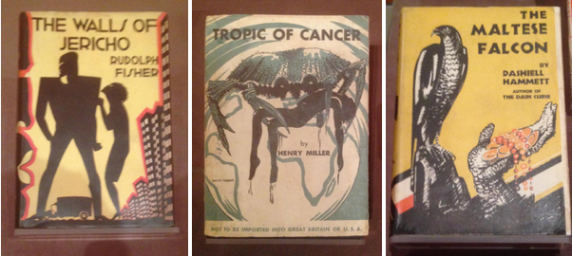September 12, 2014
What’s inside a book cover? More than just pages
by Jacob Karpathian
For those of you hapless enough to have missed The Morgan Library’s exhibition From Gatsby to Garb that ended this weekend, it was a doozy. The exhibition pulled a selection of volumes from the vault (yes, they actually have a steel-lined book vault, so take a moment to imagine J.P. twiddling his stash while reading a manuscript within 12 inches of steel) in order to present the origin of the modern book design. The Roaring Twenties gave birth to many great things: the radio and the liquid-fueled rocket, the flapper and the rise of Jazz, and, most importantly, the modern book cover, graphically bold and colorful, representing the themes of the narrative within.
Here are a few of my favorite from the exhibition:
The Walls of Jericho (originally published 1928) was Rudolph Fisher’s first novel, and a seminal work of the Harlem Renaissance that focuses on black unity and the discovery of the self. Langston Hughes called Fisher’s writing “flavored with the sharpest and saltiest humor.” Soon after, in 1929, Dashiell Hammett’s The Maltese Falcon flew off the presses. Best known by its cinematic remake, starring Mary Astor and Bogie, the book gave definitive shape to the genre of hard-boiled, detective fiction. Last, but certainly not least, Henry Miller published the Tropic of Cancer in 1934, both loved and feared for its prurient prose. With a cover that aptly expresses its lascivious content, it was first published in France because it was too explicit for puritanical American audiences.
In What We See When We Read, Peter Mendelsund asks exactly that question: what do we visualize when we read a novel. Mendelsund, vaunted by many as one of the best in the cover art business, takes a “phenomenological” approach to the question. He points out that authors often provide more behavioral details than physical descriptions of characters. Thus, the physical appearance of a character is a co-creation with the author. In conversation with Mendelsund, Leanne Shapton at Manhattan’s 192 Books, visual artist and author, recalled working on a cover design where the author repeatedly grew frustrated with her illustration of the protagonist, and eventually sent her a Guess ad. Sharpton explained that she sometimes thinks of covers in a sartorial dimension—the book’s jacket. However, it is an overcoat that is more than prosaic.
But the question remains: what is the purpose of the book jacket? Is it the vault within which the meaning of the book is locked? The movie remake that’s more popular than the narrative itself? The clothes that a story must wear to go out in public? Mendelsund recommends aspiring cover designers to home-make covers for their favorite books. Maybe we all should personalize our most valued tombs. It’s not hard to recall the best and worst covers in your collection. So, we ask you, what are your favorite Melville covers?
